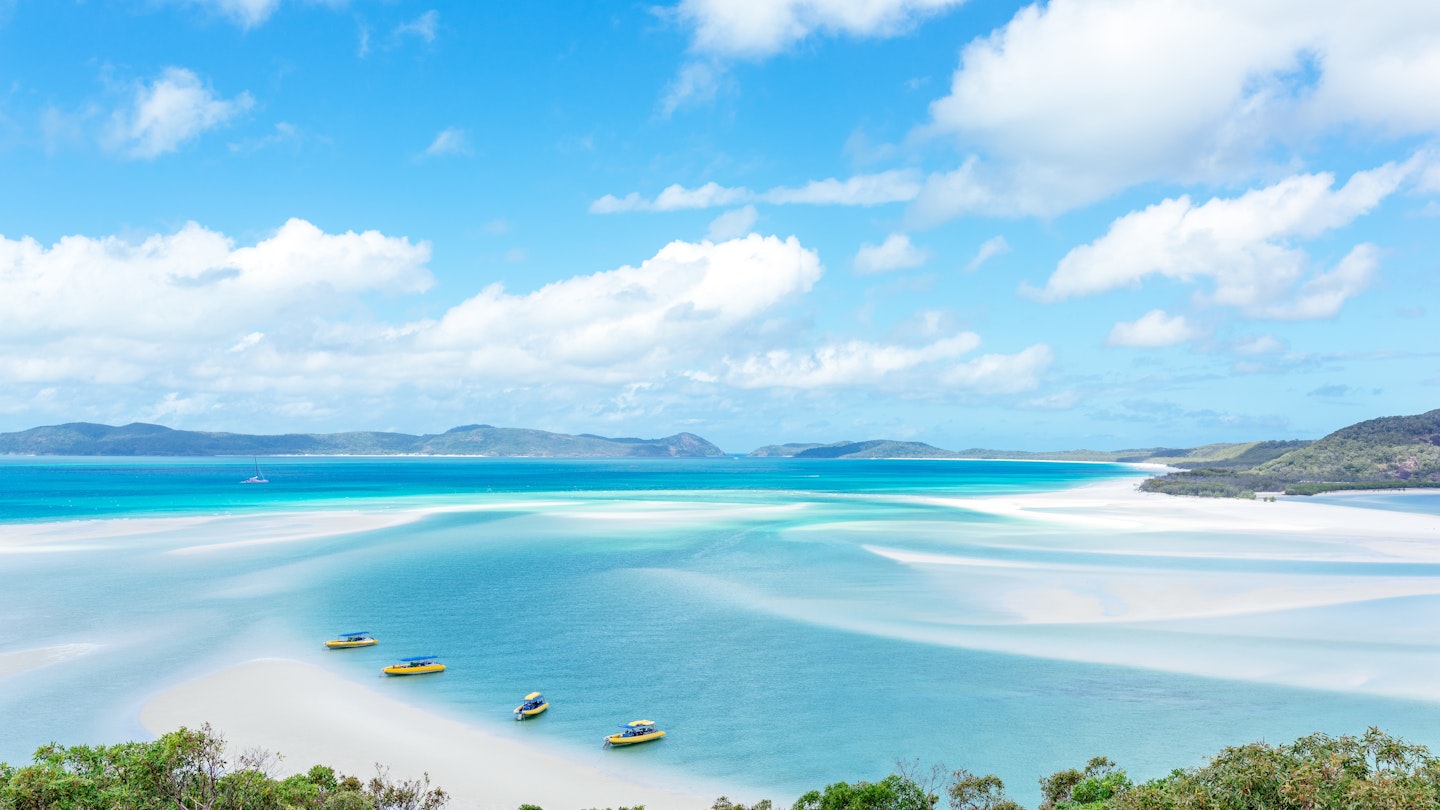While it could be argued that Australia’s best island is, in fact, Australia itself, this country-continent exports some of its best commodities offshore. With over 8000 islands, Australia offers escapes, adventures, and oddities to travelers of all stripes. Underwater, on-land, cultural, or quaint: whatever floats your boat, set sail to discover Australia’s best islands for you.
1. Beaches: Whitsunday Island
Australia’s islands boast some of the most stunning beaches on the planet: Fitzroy Island’s flawless Nudie Beach, Great Keppel’s 17 serene stretches of sand, and the untouched shores of the far-flung Cocos (Keeling) Islands, to name a few. However, for a beach so postcard-perfect it’s practically a cliché, drop your towel at Whitehaven Beach on North Queensland’s Whitsunday Island. With 7km of strikingly pure white sand and pristine turquoise waters surrounded by lush jungle, Whitehaven has earned accolades such as best beach, cleanest beach, and most eco-friendly beach from experts worldwide. Additionally, its 98% silica content means the sand won’t burn your bare feet, even on the hottest Queensland days.

2. Wildlife: Kangaroo Island
Macropods, sea lions, and koalas abound! Kangaroo Island, located 13km off the South Australian coast, is often dubbed ‘a zoo without fences’ due to its impressive array of wild, roaming animals. From the waddling colonies of Seal Bay to endemic echidnas, the island attracts nature enthusiasts. Another notable destination for wildlife is Rottnest Island, renowned for its native population of about 10,000 friendly quokkas, while Fraser Island, the world’s largest sand island, is home to a large population of pure-bred dingoes.

3. Indigenous Experiences: Bremer Island
Situated off the coast of Eastern Arnhem Land in the Northern Territory, Bremer Island is a stunning treat, both culturally and visually. Remote and largely untouched by modern life, Bremer is home to the Yolngu people, who collaborate with the island’s accommodation, Banubanu Beach Retreat, to offer visitors a taste of local indigenous customs and traditions, including basket weaving and crab catching. Furthermore, to the northeast, Thursday Island provides an immersive insight into Torres Strait Islander life and culture.

4. Diving: Heron Island
Renowned globally for its exceptional scuba diving opportunities, Heron Island (90km off the central Queensland coast) is a diver’s paradise, with warm, clear waters filled with sharks, rays, sea turtles, whales, and more than 900 tropical fish species. The World Heritage–listed marine national park caters to everyone from beginners to experts, while an island-based research center provides insights into Heron’s unique underwater world. Notably, Heron Bommie, with its spectacular coral forests, was listed among Jacques Cousteau’s top ten favorite dive destinations.
5. Snorkelling: Lady Elliot Island
The Great Barrier Reef is renowned for its stunning snorkelling, with Lady Elliot Island being one of its most isolated coral cays. Although you’ll need to take a charter flight to get there, the abundance of manta rays—an estimated 700—turtles, dolphins, whales, and countless marine species makes the trip incredibly rewarding. Moreover, Lady Elliot’s location in a marine park ‘Green Zone’ allows healthy, colorful coral to thrive, providing an ideal environment for diverse aquatic life.

6. Urban Exploring: Cockatoo Island
Not all of Australia’s islands are idyllic retreats surrounded by palm trees. Cockatoo Island in Sydney is a gritty historical complex that has served as a 1800s convict prison, a reform school for girls, a shipyard, and a naval base. Consequently, the UNESCO World Heritage site today is a slightly eerie yet highly photogenic destination. Visitors can engage in evocative tours of its heritage buildings, enjoy cafes & bars, experience live performances, and choose from various overnight accommodations—from staying in a former fire station to waterfront camping.

7. Luxury: Haggerstone Island
Lizard Island, Orpheus Island, Hayman Island, and Hamilton Island: Australia is truly spoiled for choice when it comes to luxury. However, for an unparalleled experience in island indulgence, remote Haggerstone Island—accessible via a two-hour private charter flight from Cairns—is the ultimate destination. Expect luxurious villas, exclusive access to pristine reefs, gourmet seafood feasts, custom adventures, and pampered privacy. For the most splendid isolation, consider hiring the entire island for yourself.

8. Backpackers: Magnetic Island
A stay on Magnetic Island—affectionately known as ‘Maggie’—is practically mandatory for anyone traversing Australia’s east coast backpacker trail. Located a stone’s throw from Townsville, Maggie is both a residential island and a lively party destination, thanks to its social hostels, bustling pubs, lively beach parties, and zany festivities.

9. Adventure: Lord Howe Island
If you truly want to “get away from it all,” head to Lord Howe Island, located 600km from the New South Wales mainland. With visitor numbers capped at 400, mobile phone coverage nearly nonexistent, and Wi-Fi being unreliable, the island is a serene retreat. The biggest on-land attraction, Mount Gower, offers privacy and an exquisite hiking experience. Conversely, if you seek some fishy company, explore Ned’s Beach, where clear, shallow waters host friendly fish.

10. Whale Watching: Tasmania
Bundle up and journey south to Australia’s largest island for incredible whale watching opportunities. The east coast of Tasmania lies on the migration path of thousands of whales, including humpbacks, southern rights, orcas, and even the occasional blue whale. Rugged Bruny Island, located two hours south of Hobart, is an ideal whale-watching spot. For the best viewing experience, visit between May and July to witness humpbacks on their journey north, and from September to November for their return to cold feeding grounds.





